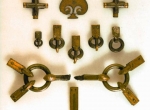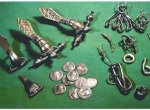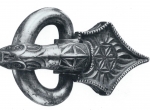Przeworsk Culture
Przeworsk culture, archaeological culture developing from late 3rd c. BC until the first half of 5th c. AD in southern and central Poland, between the Odra and the Western Bug rivers as far as the Upper Dniester, between the Noteć River and the Carpathian foothills. This territory was never settled in a more uniform manner, some parts became depopulated, others were settled anew. The culture takes its name from a village near the town of Przeworsk, the site of the first cemetery of this unit to be identified (Gać). P. c. evolved out of a local substrate of Pomeranian culture, with a very strong contribution from La Tène culture. It is known from a large number of cemeteries and settlements, its distinctive features are the following: prevalence or near domination of cremation, a large number of weapons and implements deposited in male graves, a high frequency of ornaments and dress accessories made of iron, the effect of well-developed metallurgy pursued in centres in Mazovia and the Holy Cross Mts., during the Late Roman Period also in Upper Silesia. P. c. was socially stratified, as indicated by very rich burials provided with many provincial Roman imports, most notably, bronze and glass vessels.
During the 4th c. and early into the 5th century P. c. experienced economic growth, expressed by the use of iron ploughshares and coulters which made possible cultivation of heavier soils, and by the operation of numerous centres of wheel-turned pottery production. These advances are most apparent in Silesia and Lesser Poland whereas the region at the foot of the Carpathians evidently became more densely populated. Large cemeteries continue in use until the beginning of the 5th century, and in case of Mokra, Kłobuck district, even for a little longer. A new development observed in the closing phases of these cemeteries is deposition of cremation burials, complete with the pyre debris and scattered grave goods, in a single layer, defined as “type Dobrodzień” burial; new, smaller cemeteries with such a layer are established as well. Also recorded is a small number of inhumation graves and inhumation cemeteries. This stable situation is disrupted on the turn of the 4th and the 5th century. The archaeological record now includes a number of graves containing nomad elements: at →Jakuszowice (warrior burial with e.g., a reflex bow, fig. 1.), →Przemęczany (burial of an individual with an artificially deformed skull) and at →Jędrzychowice (a deposit with a Hunnic cauldron and a cut up gold diadem). These finds all suggest that the southern reaches of Przeworsk culture territory had come under the influence, possibly even the rule of the Hunnic →Huns state on the Middle Danube. The developments within P. c. during the first half of the 5th c. are reflected by the closing phases of the settlement at →Jakuszowice , with many metal finds, several settlements in the Beskid Sądecki mountain range, where some of the pottery finds are attributed to the Northern Carpathian group, and at →Świlcza (fig. 2.), with its hoard containing brooches type Wiesbaden and a dendrology date of 433+10. A number of finds belong in the late phase of the Migration Period (D2), most likely, the first quarter of the 5th c.: buckles from Strzegocice, Tarnów district, from settlements at Aleksandrowice and →Piwonice , both near Kraków, and from Pyszków in central Poland, all of them type Strzegocice-Tiszaladány-Kercz, provenanced to the Middle or the Lower Danube. The summit of →Góra Birów , a limestone monadnock at Podzamcze, Zawiercie district, has yielded metal finds dating to the first and second half of the 5th century. Przeworsk occupation during the same period is documented in the caves of Kraków-Częstochowa Upland which may have been used as temporary shelter in the face of impending unrest. The cemetery at Żerniki Wielkie in Lower Silesia, its onset datable only broadly to phases C3-D1 (early stage of the →Migration Period ) with oddly positioned inhumation burials, also intimates an unstable situation of the population.
From central Poland, on the Prosna, Warta and Bzura rivers, we have a significant concentration of stray finds of metal objects and of hoards, dated to the first, possibly the second half of the 5th c. even late 5th-onset of the 6th century: e.g., hoards of ornaments, medallions and solidi →Solidus from →Zagorzyn (fig. 3.) and →Konarzew . Attributable to the same time period are three inhumation graves identified at →Oszczywlik .
In recent years thanks to the use of metal detectors the number of finds of 5th and 6th century metal artefacts has been increasing, most of them still await publication. Some of them have evident ties with the lands on the Elbe River, others with the Danubian region, still others, with Scandinavia, but all are in need of in-depth analysis.
At the current level of research we may assume that P.c. declined around mid-5th century and that the main cause for its ultimate fall was expansion of Slav tribes. Finds that have a later dating are not necessarily associated with the survival of this culture in some areas, e.g., in Central Poland, rather, they may document the penetration of the abandoned territory by other, not very large, groups of population.
MM
Literature: K. Godłowski, Przemiany kulturowe i osadnicze w południowej i środkowej Polsce w młodszym okresie przedrzymskim i w okresie rzymskim, Prace Komisji Archeologicznej 23, Wrocław 1985; K. Pieta, The North Carpathians at the beginning of the Migration Period, Antiquity 65/247, 1991, p. 376-387; K. Godłowski, Das „Fürstengrab” des 5. Jhs. und der „Fürstensitz” in Jakuszowice in Südpolen [in:] La noblesse romaine et les chefs berbares du IIIe au VII siecle, Condé-sur-Noireau 1995, p. 155-179; R. Madyda-Legutko, Zróżnicowanie kulturowe polskiej strefy beskidzkiej w okresie lateńskim i rzymskim, Kraków 1996; A. Bursche, Złote medaliony rzymskie w Barbaricum. Symbolika prestiżu i władzy społeczeństw barbarzyńskich u schyłku starożytności, Światowit, Supplement Series A: Antiquity 2, Warszawa 1998; M. Mączyńska, Schyłkowa faza kultury przeworskiej, Kultura przeworska 4, 1999, p. 25-53; Przeworsk-Kultur. Jüngere vorrömische Eisenzeit. Frühe römische Kaiserzeit, [in:] H. Beck, D. Geuenich, H. Steuer (eds.), Relallexikon der Germanischen Altertumskunde, vol. 23, Berlin-New-York 2003, p. 540-553 (T. Dąbrowska); Przeworsk-Kultur. Jüngere und späte Römische Kaiserzeit, [in:] H. Beck, D. Geuenich, H. Steuer (eds.) Reallexikon der Germanischen Altertumskunde, vol. 23, Berlin-New York 2003, p. 553-567 (M. Mączyńska); J. Andrzejowski, A. Kokowski, Ch. Leiber (eds.), Wandalowie, strażnicy bursztynowego szlaku. Katalog wystawy, Lublin-Warszawa 2004.
-
 full resolution
full resolution
Fig. 1. Horse bit and gold horse trappings from the grave at Jakuszowice (W. Menghin, Germanen, Hunnen und Awaren. Schätze der Völkerwanderungszeit, Nürnberg 1987).
-
 full resolution
full resolution
Fig. 2. Hoard of silver ornaments from a settlement at Świlcza near Rzeszów (J. Andrzejowski, A. Kokowski, Ch. Leiber 2004).
-
 full resolution
full resolution
Fig. 3. Siver buckle from the Zagórzyn Hoard (A. Bursche 1998).


